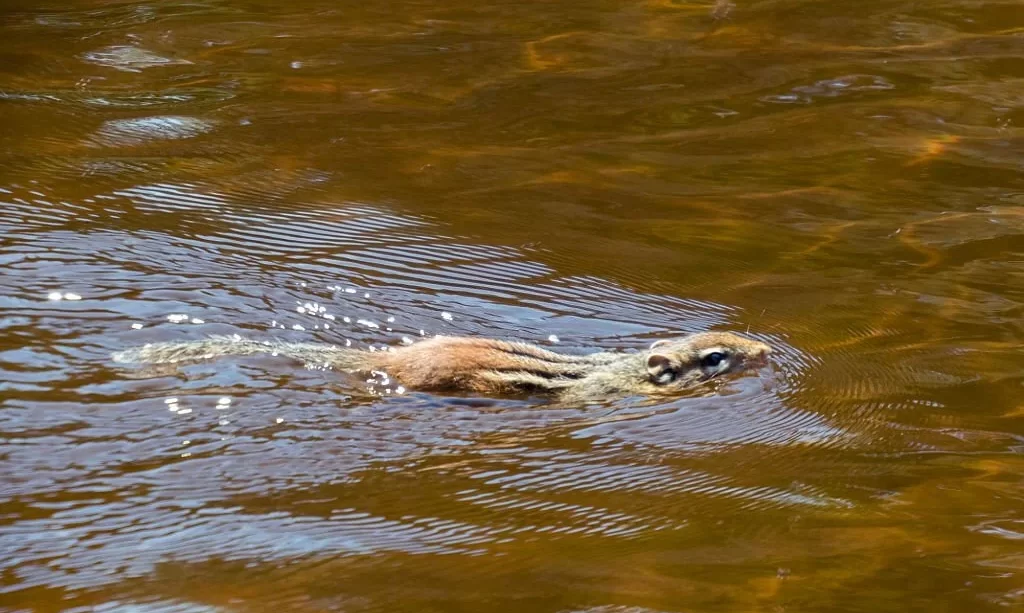Squirrels, those agile and bushy-tailed creatures, are often celebrated for their remarkable terrestrial feats. Their mastery of leaping between branches and dashing across the ground has captivated the imagination of many. But beyond their well-known land-based abilities lies a lesser-explored aspect of their behavior. This article delves into the question: Do squirrels swim? Squirrels are usually associated with their tree-dwelling and ground-dwelling habits, yet their potential aquatic prowess remains a topic of curiosity. The aim of this article is to uncover the lesser-known aquatic capabilities of squirrels and explore the circumstances that lead these terrestrial creatures to take to the water.
The Land-Dwelling Squirrel
Squirrels are renowned for their terrestrial agility, often seen darting among trees or scurrying across the ground. Their adaptation for life on land is notable, with sharp claws for climbing and powerful hind legs for swift movement. These ground-dwelling acrobats are known for their resourcefulness in locating food and their expert seed and nut caching techniques. Their proficiency in navigating their terrestrial environment is unquestionable.
Squirrel Swimming
While the image of squirrels on land is familiar to many, their abilities in the water remain a lesser-explored territory. The idea of squirrels swimming may come as a surprise, as their adaptations for terrestrial life are well-documented. However, there are situations where squirrels may find themselves in or near water, prompting them to reveal their aquatic potential. In the following sections, we will unravel the mystery of squirrel swimming and explore the adaptations that enable these creatures to tackle the challenges of aquatic environments.
Squirrel Adaptations for Swimming
Squirrels, despite their terrestrial reputation, possess some intriguing adaptations that facilitate swimming. One key adaptation is their fur. The fur of squirrels is designed to trap air, creating a layer of insulation that helps keep them buoyant in the water. This buoyancy is a crucial feature that aids in their ability to stay afloat while swimming. Additionally, the natural oils in their fur can act as a water repellent, preventing their fur from becoming waterlogged, which would make swimming more challenging.
Their powerful hind limbs, typically used for leaping and climbing, play a vital role in swimming. Squirrels employ a kicking motion similar to that of a frog to propel themselves through the water. This action allows them to navigate and move with relative ease.
Squirrel Behavior in Aquatic Environments
When squirrels find themselves in aquatic environments, their behavior adapts to the circumstances. They may display a cautious approach to water, especially when faced with unfamiliar or deep bodies of water. However, if necessary, they can swim with surprising agility.
Squirrels tend to swim with their bodies mostly submerged, leaving only their head and the tip of their tail visible above the water’s surface. Their tails, which are often their signature feature, play a crucial role in maintaining balance and steering as they swim.
It’s important to note that while squirrels are capable swimmers, they do not typically seek out water as a primary habitat. Swimming is more of a survival adaptation, and squirrels will avoid water if they can. Their primary habitats and behaviors are firmly grounded in the world of trees and land.
The circumstances under which squirrels might encounter water and be compelled to swim can include crossing streams, rivers, or ponds to reach new territories, find food, or escape predators. Additionally, during certain seasons, squirrels may swim while foraging for aquatic plants, small invertebrates, or even to access bird’s nests, which are sometimes built near water sources.
The behavior of squirrels in aquatic environments reveals their adaptability and resilience in the face of challenges, even when confronted with a world quite different from the familiar trees and land they call home.
When and Why Squirrels Swim
The occasions when squirrels might find themselves swimming are often tied to survival and necessity. These situations may include foraging for aquatic plants or small invertebrates, reaching distant territories, or escaping predators. Squirrels, resourceful by nature, adapt to the challenges of aquatic environments when the need arises.
During certain seasons, the availability of aquatic food sources can drive squirrels to venture into the water. Some squirrels have even been observed foraging for fish or eggs in bird nests situated near water bodies. These instances showcase the flexibility and adaptability of these small, agile creatures.
Conclusion
Squirrels, with their well-known terrestrial agility, possess an intriguing and relatively lesser-known aquatic side. While they are not aquatic animals by definition, their ability to swim is a testament to their adaptability and resourcefulness in the face of diverse challenges. The question of whether squirrels swim is answered with a resounding “yes,” even though these moments in aquatic environments are generally born out of necessity rather than preference.
This revelation offers a fascinating glimpse into the complex and versatile world of squirrels, which continue to inspire curiosity and wonder. Whether scurrying across land or gracefully navigating water, squirrels remind us of the diverse and unexpected abilities that can be found in the animal kingdom, just waiting to be uncovered and explored.



